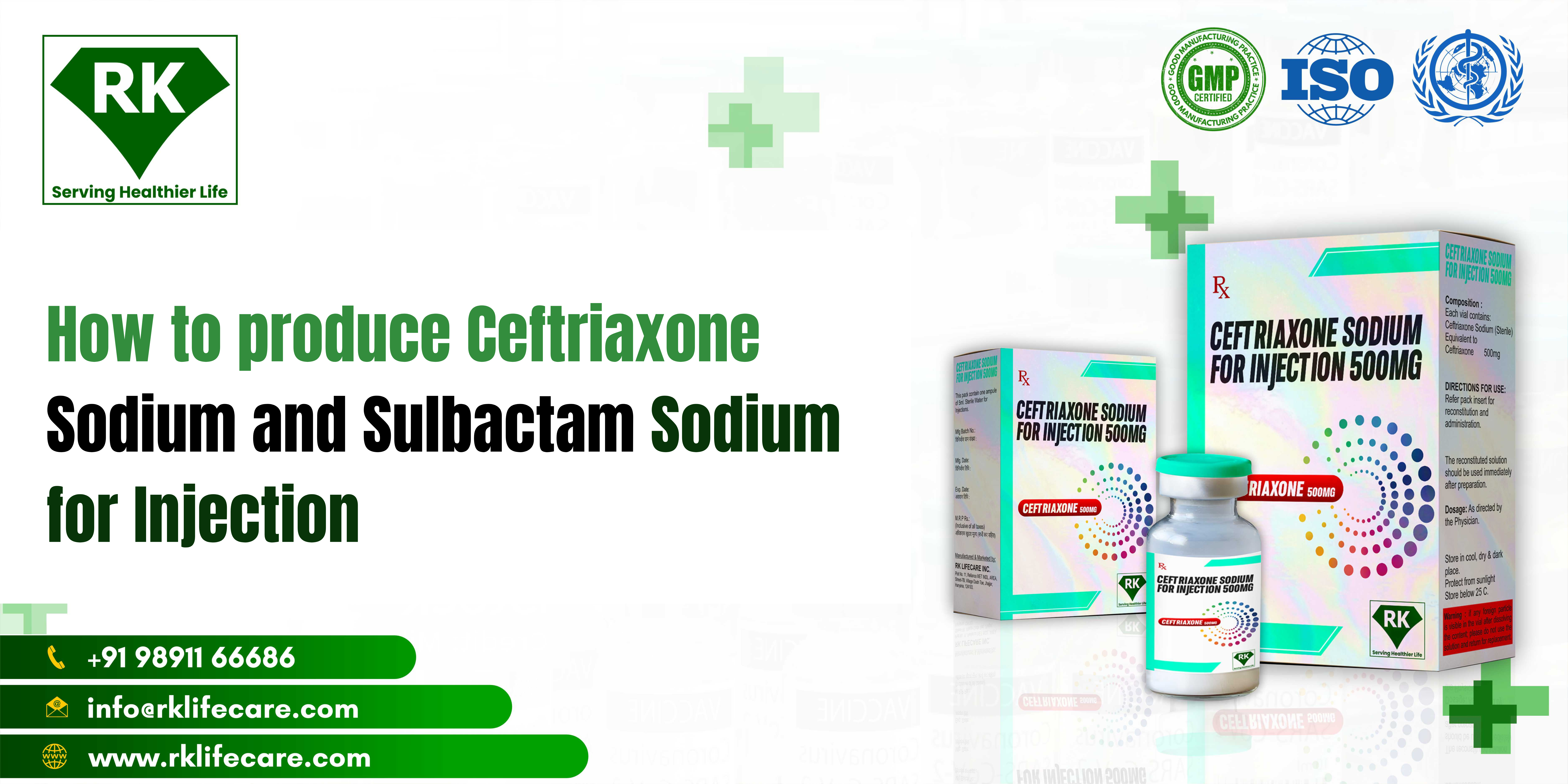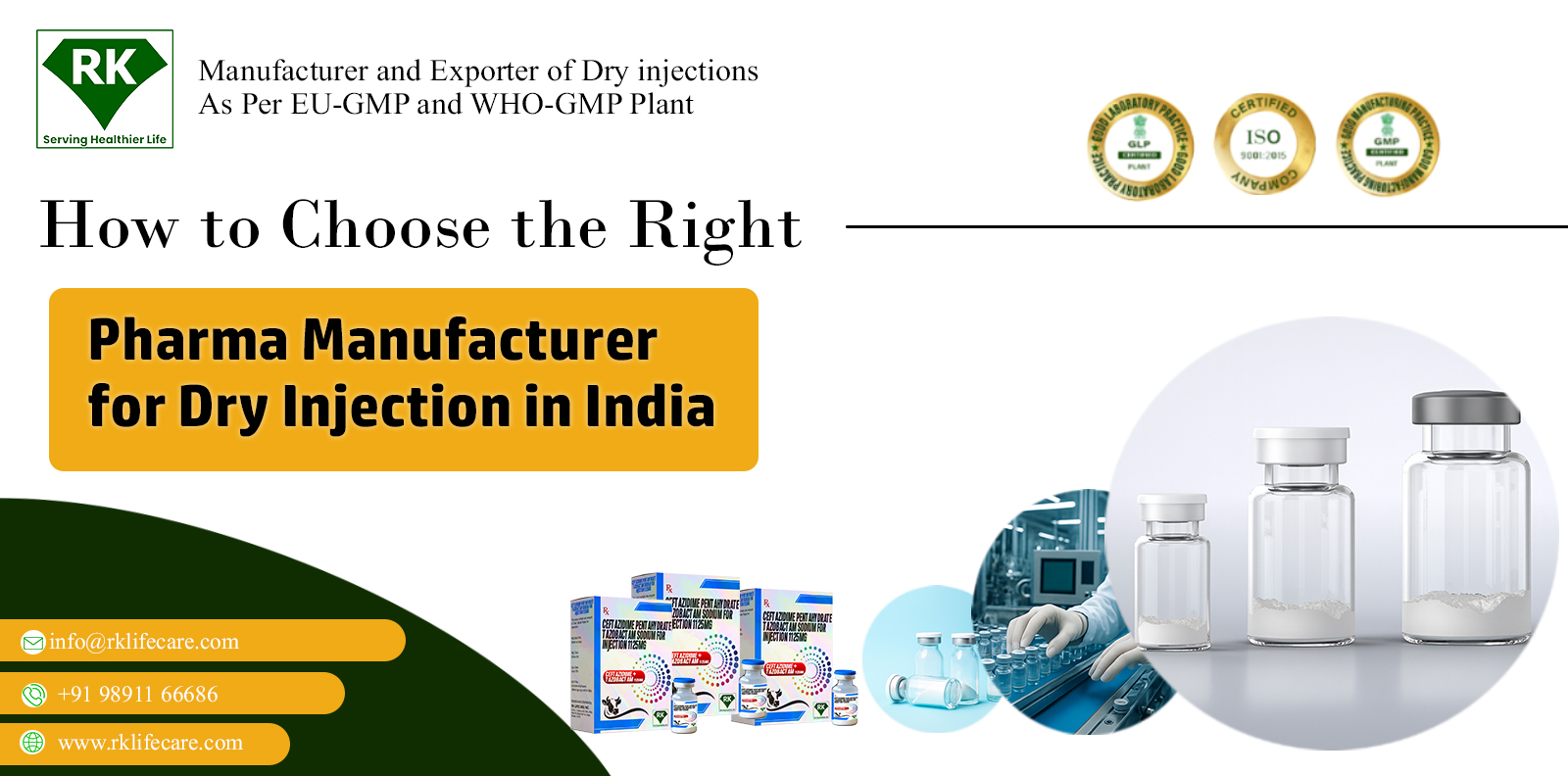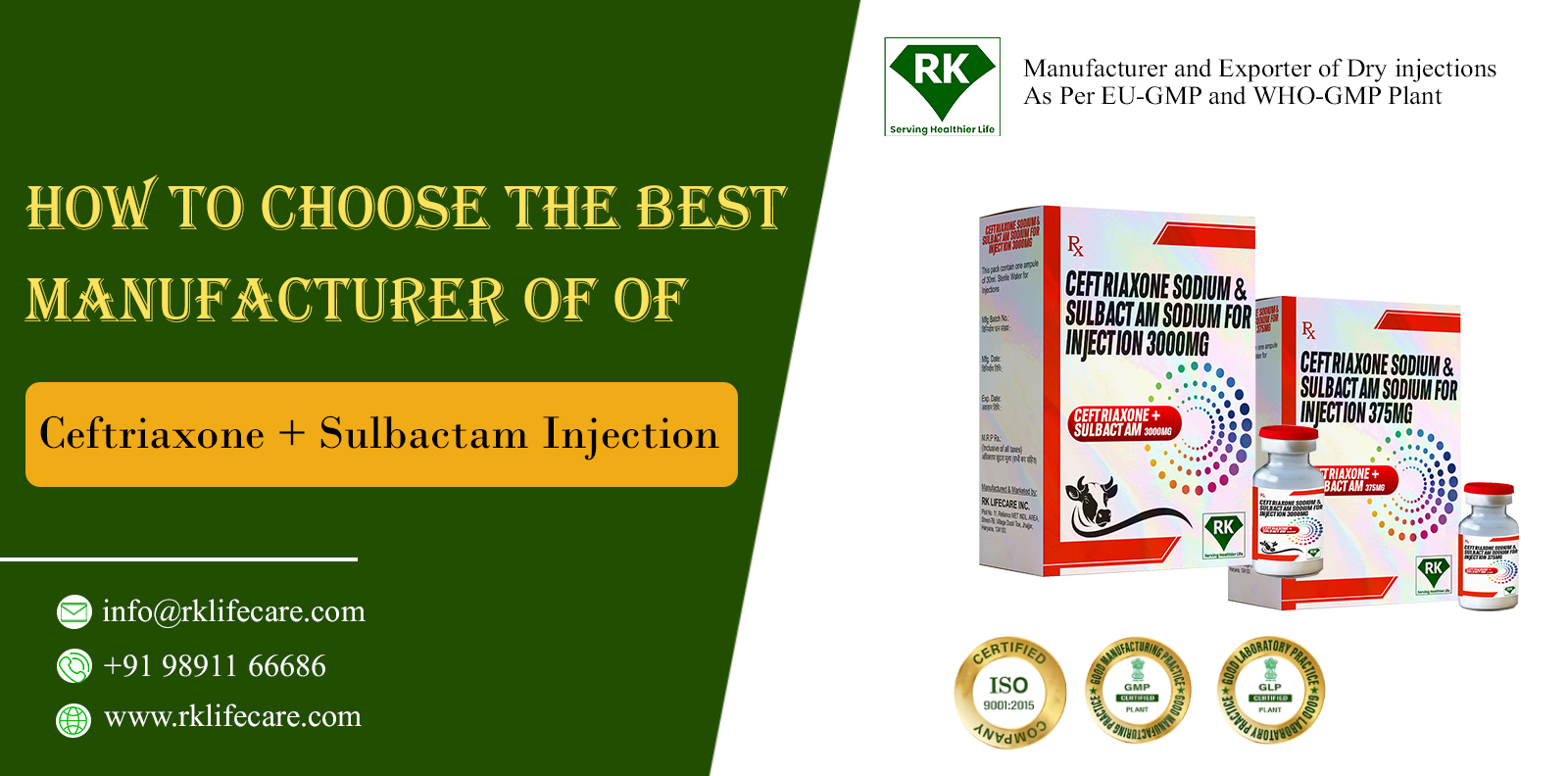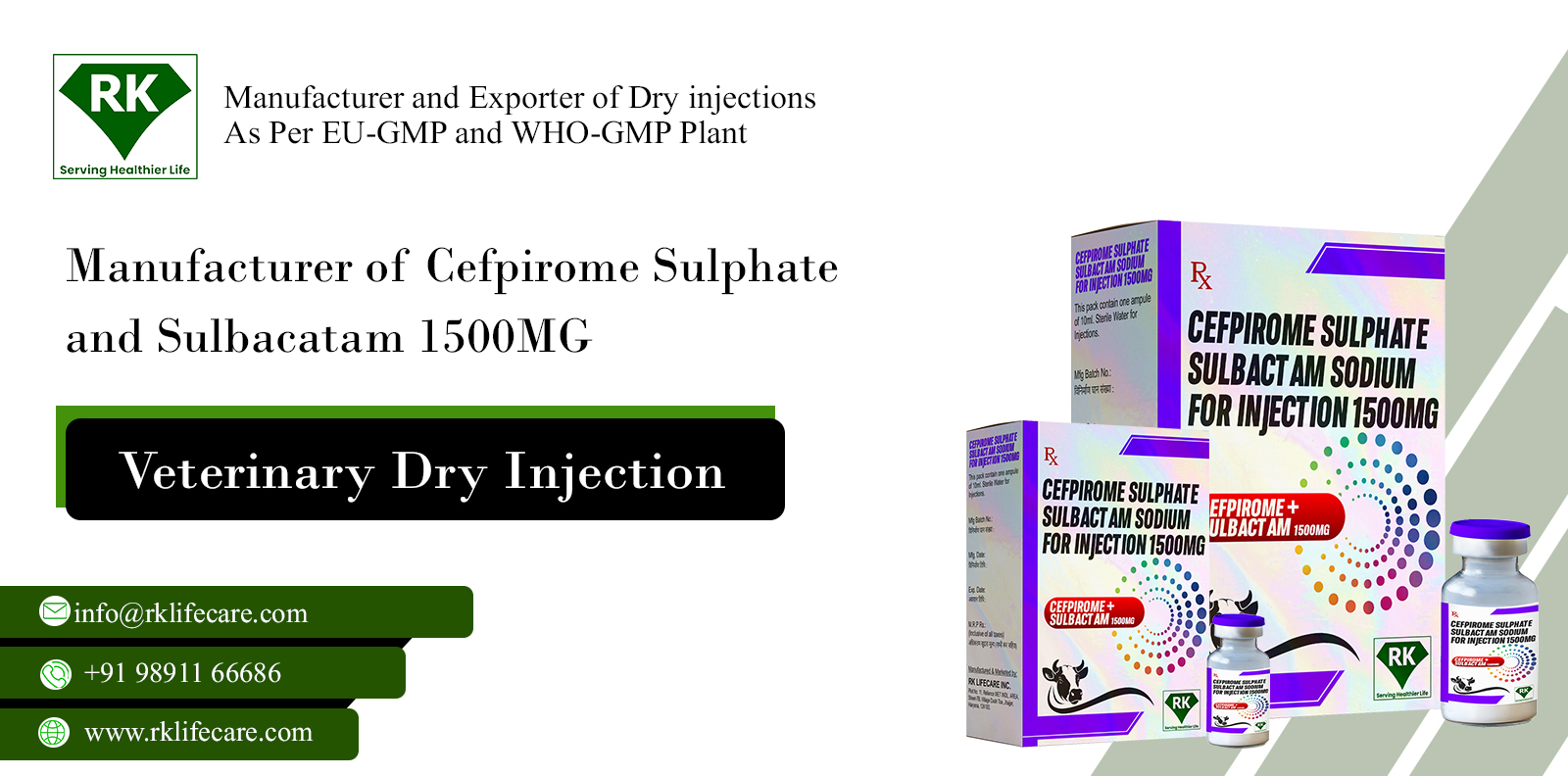
In the world of parenteral pharmaceutical products, Ceftriaxone Sodium and Sulbactam Sodium for Injection stands out as a powerful combination used to combat a wide range of bacterial infections. This sterile injectable formulation combines the third-generation cephalosporin ceftriaxone with the beta-lactamase inhibitor sulbactam, increasing its efficacy against resistant organisms.
Manufacturing this formulation requires precision, regulatory compliance, a sterile environment, and a highly experienced technical team. As a company deeply involved in dry powder injectable manufacturing, we bring a wealth of experience, expertise, and confidence in producing Ceftriaxone-Sulbactam Injection with the highest standards of safety and efficacy.
1. Experience in Dry Injection Manufacturing
1.1 Our Manufacturing Heritage
With decades of pharmaceutical manufacturing experience, we at R K Lifecare Inc. have developed a firm grasp on aseptic techniques, sterile formulation development and Good Manufacturing Practices (GMP). Our practical experience in handling beta-lactam antibiotics, including third-generation cephalosporins such as ceftriaxone, is evident in our production results, market acceptance and regulatory compliance.
1.2 Handling of Potent APIs
Given the allergenic and potent nature of cephalosporins, producing dry injections of ceftriaxone and sulbactam requires strict containment strategies. Our facility design includes:
-
Dedicated beta-lactam blocks
-
Class 100 (ISO 5) cleanroom environments for filling
-
Validated air handling units (AHUs) with HEPA filters
-
Dedicated HVAC systems
-
Airlocks and pressure differentials
These ensure that cross-contamination risks are eliminated and product sterility is maintained at every stage.
2. Expertise in Formulation and Manufacturing
2.1 Active Pharmaceutical Ingredients (API) Profile
-
Ceftriaxone Sodium (USP/IP/BP grade): A bactericidal agent with broad-spectrum activity.
-
Sulbactam Sodium (USP/IP/BP grade): A beta-lactamase inhibitor that extends Ceftriaxone’s spectrum against resistant strains.
Our R&D and QA teams ensure both APIs:
-
Meet pharmacopeial specifications
-
Have low residual solvents
-
Show desired microbiological purity
-
Exhibit correct particle size distribution for proper blending
2.2 API Ratio Optimization
The commonly used clinical formulation is:
-
Ceftriaxone Sodium: 1000 mg
-
Sulbactam Sodium: 500 mg
OR -
Ceftriaxone Sodium: 500 mg
-
Sulbactam Sodium: 250 mg
This 2:1 ratio is critical to preserve the synergy between both agents. Our formulation chemists perform:
-
Compatibility studies
-
Moisture content analysis
-
Stability studies under ICH guidelines
-
Pre-formulation trials for powder behavior, flow properties, and sterility retention
3. Step-by-Step Manufacturing Process
3.1 Raw Material Procurement and Testing
All raw materials are sourced from GMP-certified vendors and tested as per pharmacopeial standards. Key tests include:
-
Identification (IR/UV)
-
Assay (HPLC/UV)
-
Water content (Karl Fischer)
-
Sterility
-
Microbial limits
-
Heavy metals
All raw materials receive approval from Quality Control (QC) before being released to production.
3.2 Dispensing
-
Carried out in a Class 100,000 (ISO 8) area
-
Operators wear sterile gowning
-
Ingredients are weighed using calibrated balances
-
Dispensing is performed in reverse laminar airflow (RLAF) booths to minimize contamination
3.3 Dry Mixing and Blending
After weighing:
-
APIs are transferred to a Rapid Mixer Granulator (RMG) or double cone blender
-
Mixing duration and speed are validated
-
Blend uniformity is tested using content uniformity assays
-
In-process control (IPC) is performed to check for segregation, particle agglomeration, and flowability
3.4 Sterile Filtration & Aseptic Transfer (if solution is prepared)
For lyophilized injections, dry powder filling is standard. However, some formulations require:
-
Solution preparation in Water for Injection (WFI)
-
pH adjustment
-
Sterile filtration using 0.22-micron filters
-
Transfer to sterile filling area
This step must be conducted in Class 100 (ISO 5) zones under strict aseptic conditions.
3.5 Vial Washing and Sterilization
Vials are washed using 5-stage vial washing machines using:
-
Purified Water (PW)
-
WFI
-
Compressed air
-
Drying with laminar airflow
Post-washing, vials are depyrogenated in hot-air tunnels at 320°C.
3.6 Sterile Powder Filling
In our sterile fill area:
-
Mixed powder is filled using automatic sterile powder filling machines
-
Nitrogen purging is applied before and after filling
-
Fill weight consistency is checked every 15-30 minutes
-
Class 100 environment is strictly maintained with restricted operator movement
3.7 Rubber Stoppering and Sealing
-
Sterile rubber stoppers are placed immediately after filling
-
Aluminum seals are crimped onto the vials using automated sealing machines
-
Visual inspection is performed under white and black light backgrounds to identify particulate matter, cracks, or foreign particles
4. Lyophilization (Optional)
In case of lyophilized formulation:
-
Vials are pre-frozen at -40°C
-
Transferred to a lyophilizer for sublimation under vacuum
-
Final moisture content is targeted to be <1%
-
The dried cake should appear uniform, white/off-white, and porous
Post-lyophilization, vials are sealed under vacuum or nitrogen.
5. Quality Control and Assurance
5.1 In-Process Checks
-
Blend uniformity
-
Weight variation
-
Environmental monitoring
-
Sterility assurance
5.2 Finished Product Testing
Each batch undergoes:
| Test | Method |
|---|---|
| Appearance | Visual |
| pH | Potentiometry |
| Reconstitution Time | Manual test |
| Water Content | Karl Fischer |
| Assay | HPLC |
| Related Substances | HPLC |
| Sterility | Membrane Filtration |
| Endotoxins | LAL Test |
| Particulate Matter | Visual + Light Obscuration |
| Uniformity of Content | Spectrophotometry / HPLC |
Only batches meeting all QC parameters are released for packaging.
6. Packaging and Labeling
Packaging is done using:
-
Glass vials (USP Type I)
-
Sterile rubber stoppers
-
Aluminum flip-off caps
Final labeling is done in compliance with DGCI, WHO, and global regulatory standards. Labels include:
-
Brand name
-
Composition
-
Batch No.
-
Manufacturing and Expiry Dates
-
Storage Conditions
-
Reconstitution Instructions
7. Storage and Shelf Life
-
Store at <25°C, away from light and moisture
-
Shelf life: 24 to 36 months, depending on stability data
Reconstituted solution (in sterile water/lidocaine) should be used within 6 hours at room temperature or 24 hours if refrigerated.
8. Regulatory and Compliance Aspects
We follow:
-
WHO-GMP
-
PIC/S
-
Schedule M
-
US FDA, EU GMP guidelines for future market expansions
Each batch is documented through:
-
Batch Manufacturing Records (BMR)
-
Batch Packaging Records (BPR)
-
Certificate of Analysis (COA)
-
Certificate of Compliance (COC)
9. Environmental and Worker Safety
As a responsible dry injection manufacturer, we implement:
-
Effluent Treatment Plants (ETP)
-
Solvent recovery units
-
HEPA exhaust systems
-
Worker PPEs, training modules, and biosafety drills
Handling cephalosporins demands a closed-loop system to avoid occupational exposure, and our operations reflect this care.
10. Trust Through Continuous Improvement
Our client-centric approach, transparent documentation, and zero-defect policy have earned us long-standing trust with:
-
Government tenders
-
Private hospitals
-
Exporters and distributors
We constantly upgrade our systems through:
-
Six Sigma methods
-
LEAN manufacturing
-
Regulatory audits and certifications
Our repeat clientele and regulatory inspections passed without major observations demonstrate our commitment to quality.
RK LIFE CARE INC specializes in producing high-quality Ceftriaxone Sodium and Sulbactam Sodium injections with strict adherence to pharma standards.
13 Dec 2025

08 Dec 2025

03 Dec 2025

02 Dec 2025

31 Oct 2025